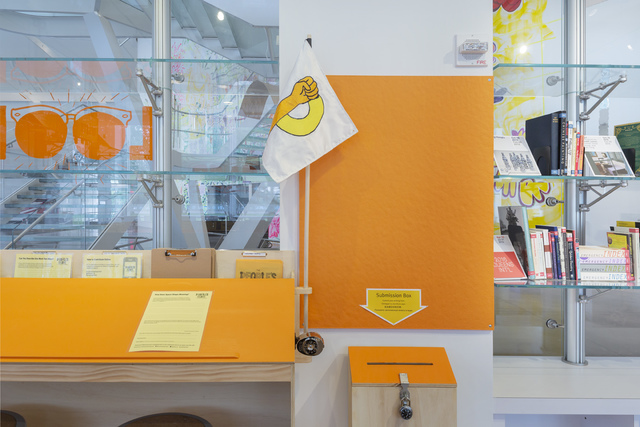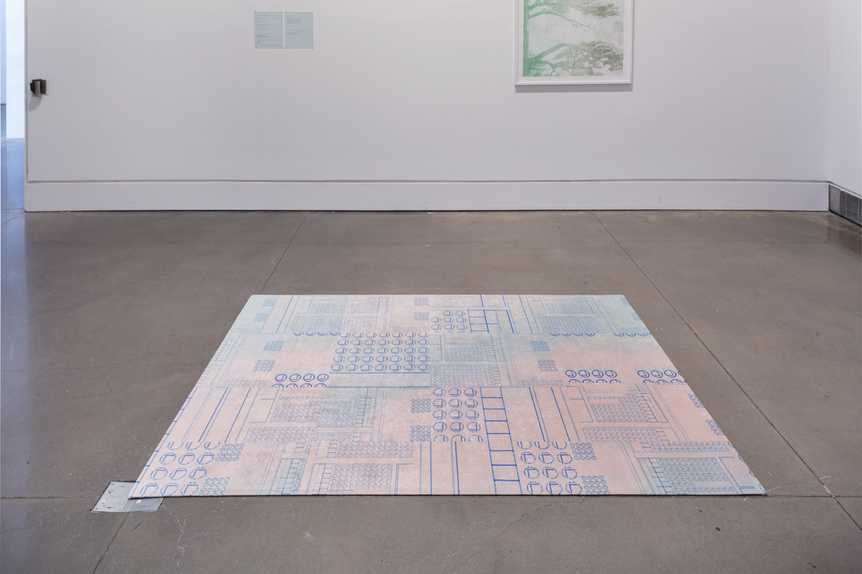-
From Current Issue
-
- Editor’s Letter Fire in the Heart
- Reviews I Gusti Ayu Kadek Murniasih
- Reviews 11th Seoul Mediacity Biennale: “One Escape at a Time”
- Dispatch Networked China
- One on One Monira Al Qadiri on Yukio Mishima
- Essays The rise of independent art spaces in pandemic-era Shanghai
- Features Tuan Andrew Nguyen
- Table of Contents
- Web Exclusives
- Archive
- Subscribe

R
E
V N
E
X
T
Installation view of HEIDI HOWARD and LIZ PHILLIPS’ Relative Fields in a Garden, 2018, site-specific installation, acrylic paint, ceramic, bamboo, birch veneer, mirror film, metal chairs, Serge analog synthesizer, sound transducers, light sensors and multichannel looping audio players: durations variable, 2,800 × 1,000 cm, at Queens International 2018, Queens Museum, New York, 2018–19. All images by Hai Zhang; courtesy Queens Museum.
Curated by Sophia Marisa Lucas, assistant curator at New York’s Queens Museum, and performance artist Baseera Khan, the 2018 edition of the biennial Queens International offered a curatorial approach that was as conceptually robust as the works by the 43 Queens-based participating artists and collectives, representing 15 neighborhoods and several generations.
“Volumes” began in the Queens Museum’s entrance area, where benches sourced from the local public park system were placed under the skylight, creating an evocation of an outdoor commons. Suspended from the skylight was the over-12-meter-long banner Volumes Cyanotype (2018), which commemorates a dinner shared between the exhibition’s contributors. The guests were each invited to bring a meaningful object to the event. These were then exposed on the tablecloth that was used during the meal. The collaborative piece was the lynchpin of the exhibition, embodying its spirit of active and reflexive community engagement.
“Volumes” marked the first time that Queens International had a presence outside of the museum’s walls, with installations in three Queens Library branches: LeFrak, Flushing and Central. With the goal to question how knowledge and information are collected and distributed, “Volumes” embraced all the meanings of its title, including a book or a quantity of data. As such, the libraries, in addition to the museum, were fitting, integral sites of the exhibition.
Installation view of MO KONG’s Black Cloud, Thin Ice, 2018, five digital prints on phototex, 137.2 × 228.6 cm, at Queens International 2018, Queens Library, New York, 2018–19.
Mo Kong’s commissioned project Black Cloud, Thin Ice (2018) was installed on the ground level of the Flushing library, a bustling resource hub for locals—mostly Asian-Americans. Kong’s piece is composed of five prints that come together to form one composition, with poetic text sprawling across a background image of a pollen specimen under a microscope. The pollen is from a honey sample that Kong found through his research, conducted with the Shanxi Agricultural University, as well as the Rhode Island School of Design’s Nature Lab, the results of which show that honey in the United States is often mixed with other honeys from the world, though often touted to be “made by American bees.” The text is narrated from the point of view of a child who is told not to “wander and to go home,” and who, in response, walks in tears thinking, “New York is my home too.” This dynamic between protective immigrant parents and children, and the challenge of locating “home,” resonates with the experiences of many families. As a whole, the work prompts the question: could immigrants ever feel at home and be accepted in the US?
In each library location as well as the museum itself is The People’s Guide to the Queens International (2018), a project by artist Christine Wong Yap in collaboration with art critic Brian Droitcour that gave audiences a chance to give feedback on the show, as well as read other people’s comments online. Questions that guided visitors’ interpretations of the works were also provided. At the Flushing library, the first question Yap and Droitcour posed was: “What does home look like?”
In the museum, Asif Mian’s installation Nothingness and Specter (2018) was also an investigation of whose bodies are accepted and can be deemed “at home.” Four pieces of clothing fashioned from recycled plastic materials were loosely propped up at the edge of the commons area. A rotating space heater and a cooler moved near the clothing, causing them to sway. As the plastic was subjected to heat, a surveillance camera that captures thermal imagery—commonly used by the police to target black and brown male bodies in areas like Queens, according to the artist—picked up the image of the clothing, and the footage was shown on a nearby screen. When the plastic cooled, the monitor went blank. As the screen flickers, Mian gestures towards the possibility of manipulating surveillance technologies, such that all bodies are allowed to exist freely in public space.
Installation view of ASIF MIAN’s Nothingness and Specter, 2018, mixed-media sculpture of polyethylene plastic bags, heat guns, acrylic, and live camera feed from FLIR thermal camera onto flatscreen, 180.3 × 325.1 × 157.5 cm, at Queens International 2018, Queens Museum, New York, 2018–19.
The violence and hegemony of bureaucratic structures was similarly revealed in Jesse Chun’s floor-based Primary Language ( ) (2018), a shimmering textile bearing abstract patterns manipulated from electronic answer sheets for standardized English tests. Chun transformed what could be daunting into an inviting space of blank possibilities, suggesting a landscape where perhaps the trauma of forced assimilation can be undone.
KT PE Benito’s mixed-media-on-pegboard installation Entries to Faustina (Growing out of colonialism for my grandmother’s sake) (2018) speaks personally and more directly to communal healing from the entanglements of immigration, colonialism, queerness and illness. Comprising letters, merchandise, drawings, texts and collages centered on the Filipinx diaspora, the work is a visual compilation of the artist’s family history where viewers are invited to rearrange the material.
While a common thread in many of the works was the mistrust of existing frameworks and of hierarchies, “Volumes” was not an exhibition of protest. Rather, it eschewed setting up dichotomies and remained in the open, liminal space of research, unpacking mythologies not to arrive at solutions but to open up conversation. Like the borough of Queens, there was an abundance of cultures, standards, and overall unapologetic energy.
Queens International 2018: Volumes is on view at the Queens Museum, New York, until February 24, 2019.
To read more of ArtAsiaPacific’s articles, visit our Digital Library.




















